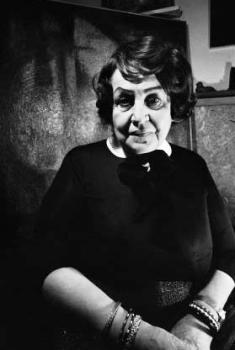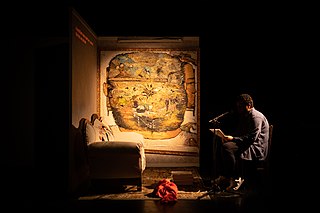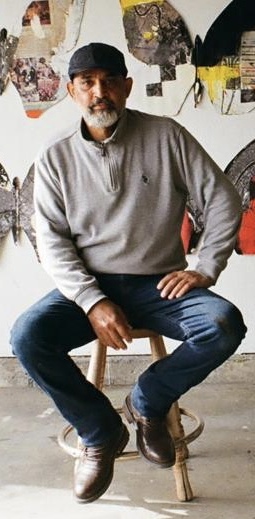Related Research Articles
James Lee Byars was an American conceptual artist and performance artist specializing in installations and sculptures, as well as a self-considered mystic. He was best known for his use of personal esoteric motifs, and his creative persona that has been described as 'half dandified trickster and half minimalist seer'.
Martin L. Puryear is an Afro-American artist known for his devotion to traditional craft. Working in a variety of media, but primarily wood, his reductive technique and meditative approach challenge the physical and poetic boundaries of his materials. The artist's Liberty/Libertà exhibition represented the United States at the 2019 Venice Biennale.

Princess Fahrelnissa Zeid was a Turkish artist best known for her large-scale abstract paintings with kaleidoscopic patterns as well as her drawings, lithographs, and sculptures. Zeid was one of the first women to go to art school in Istanbul.
Constantin Lucaci was a Romanian contemporary sculptor, best known for his monumentalist sculptures and his kinetic fountains most made from stainless steel, among which those from the Romanian cities of Reșița and Constanța are best known. He was born in Bocșa Română, today a part of Bocșa, Caraș-Severin County.

Sama Raena Alshaibi also known as Sama Alshaibi is a conceptual artist, who deals with spaces of conflict as her primary subject. War, exile, power and the quest for survival are themes seen in her works. She often uses her own body in her artwork as a representation of the country or an issue she is dealing with.
Jaber Alwan is an Italian artist and painter of Iraqi descent.
Khairy Hirzalla is a Jordanian painter, based in Amman. He works mainly in abstract art and expressionism.

Shakir Hassan Al Said (1925–2004), an Iraqi painter, sculptor and writer, is considered one of Iraq's most innovative and influential artists. An artist, philosopher, art critic and art historian, he was actively involved in the formation of two important art groups that influenced the direction of post-colonial art in Iraq. He, and the art groups in which he was involved, shaped the modern Iraqi art movement and bridged the gap between modernity and heritage. His theories charted a new Arabic art aesthetic which allowed for valuations of regional art through lenses that were uniquely Arabic rather than Western.

Mohammad Ghani Hikmat was an Iraqi sculptor and artist credited with creating some of Baghdad's highest-profile sculptures and monuments and was known as the "sheik of sculptors". He is also known as an early member of Iraq's first 20th-century art groups, including Al-Ruwad and The Baghdad Modern Art Group; two groups that helped to bridge the gap between tradition and modern art. He was also instrumental in recovering many of Iraq's missing artworks, which were looted following the 2003 invasion.
Ala Younis is a research-based artist and curator, based in Amman. Younis initiates journeys in archives and narratives, and reinterprets collective experiences that have collapsed into personal ones. Through research, she builds collections of objects, images, information, narratives, and notes on why/how people tell their stories. Her practice is based on found material, and on creating materials when they cannot be found or when they do not exist.
Tarek Al-Ghoussein, was a Kuwaiti multi-genre artist best known for his work that investigates the margins between landscape photography, self-portraiture, and performance art. His work moved away from subjects of land, belonging, nostalgia and barriers and instead gravitated toward the metaphorical transit to his ancestral homeland - Palestine. He moved between abstraction and the explicit conditions found in certain places.

Ali Cherri is a Lebanese artist working in video and installation. His varied practice focuses on documenting and presenting heritage and environment in Lebanon and other Middle Eastern countries.
Hanaa Malallah is an Iraqi artist and educator living in London, England. Her surname also appears in English as Mal-Allah. She is noted for developing the technique called the Ruins Technique in which found objects are incorporated into artwork.

Mahmoud Obaidi is an Iraqi-Canadian artist whose work has been exhibited in museums and galleries around the world.
Rafa al-Nasiri was an Iraqi painter, draughtsman, print-maker, educator and author whose works with a social and political message resonated with the Iraqi public in the mid-20th century. He was also very influential in encouraging young artists to take up print-making.
Ali Talib is an Iraqi painter, noted for his abstract works and for curating exhibitions featuring Iraqi artists.
Kadhim Haydar (1932–1985) was a highly respected Iraqi artist, poet, author, stage-set designer and educator who, as part of the first generation of modern Iraqi artists, had a major influence on the direction of modern Iraqi art. His artworks are noted for their use of symbolism, myth and poetic allegory within a contemporary framework.
Sayyid Ali Muhammad-Ali Al Tajer is an Iraqi painter and art historian. He studied drawing at the University of Baghdad's College of Fine Arts. He currently stands as a member of the Association of Iraqi Artists, as well as the Organization of Iraqi Fine Artists.

Ali Eyal, Is an Iraqi visual artist and he's currently based in Los Angeles who works internationally. His work explores the complex relationships between personal history, transitory memories, politics & identity using different media, primarily based in the medium of painting, and further transformed through other media - such as installations art, photography, text and video.

Ghassan Ghaib is an Iraqi-American artist.
References
- ↑ Krishar-Kumar, N.P. (26 March 2017). "Hadiqat Al Umma, A Powerful Display of Iraq Nostalgia". Arab Weekly. Retrieved 9 September 2018.
- 1 2 "Sadik Alfraji". British Museum. Retrieved 9 September 2018.
- 1 2 Smith, A. (28 May 2015). "reating Art Out of Darkness". Middle Eastern Monitor. Retrieved 9 September 2018.
- ↑ "At the Venice Biennale". Asian Art Newspaper. October 2017. Retrieved 9 September 2018.
- ↑ "Sadik Alfraji". Ruya Foundation. 2016. Retrieved 9 September 2018.
- ↑ Nayeri, F. (18 March 2017). "Proposed Travel Ban? At Art Dubai, 'It's Plainly Wrong". New York Times. Retrieved 9 September 2018.
- ↑ Forshaw, S. (24 August 2015). "Many Rivers to Cross". ReOrient Magazine. Retrieved 9 September 2018.
- ↑ Kalsi, Jyoti. "Truths through a Child's Eyes". Gulf News. Retrieved 19 March 2018.
- ↑ Hewett, J. (22 November 2011). "Sadik Kwaish Alfraji's Art". Time Out Magazine. Retrieved 9 September 2018.
- ↑ Chalabi, T. (2017). ""Sadik Kwaish Alfraji" At the Venice Biennale". Archaic: The Pavilion of Iraq : 57th International Art Exhibition La Biennale Di Venezia. Mousse Publishing.
- ↑ "Sadik Kwaish Alfraji: Driven by Storms". Shomo News. 1 October 2015. Retrieved 9 September 2018.